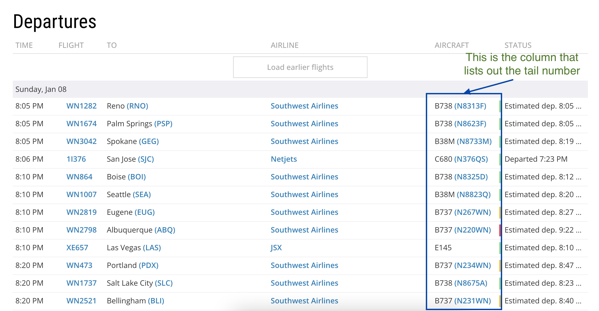- January, 2023
-
How to use flight tail numbers to track flights
This is a useful tool for people to check the status of a commercial flight using the tail number of the airplane, without the need to subscribe to any services. As a passenger, this is useful because you can see where the airplane scheduled to fly you is currently, which can help keep track of delays and cancellations.
The first step is to find the tail number of the flight that you are scheduled to take. Head to the airports page of flightradar24 and get to the page of the airport that you will be flying out of. For example, if you are flying out of Oakland, California, this would be https://www.flightradar24.com/data/airports/oak. On that page, click the "Departures" tab. This will give a list of flights, along with their tail numbers.

For example, assuming that you are flying on the 8:05 PM Southwest flight to Reno (WN1282), the tail number is under the "Aircraft" column (N8313F).
Once you have the tail number, you can use flightaware.com to track the schedule, current location, flight path. Just put the tail number into the search box. Another useful tool is airfleets.com, which can show complete airplane details, as well as links to adsbexchange.
Defined tags for this entry: geek stuff, life -
Dying with Dignity or Dying for a Lack of Support?
The expansion of Canada's euthanasia law, also known as medically assisted death (MAID), has had unintended consequences for some people with disabilities. Bill C-14, passed in 2016, legalized euthanasia for people with a "reasonably foreseeable" death. An amendment to the law, Bill C-7, further expanded the scope of legal euthanasia to include individuals suffering unbearably from a serious and incurable illness, disease, or disability, even if their death is not reasonably foreseeable. While the intention behind the law was to help people die with dignity, it has had unintended consequences for some individuals who may choose to end their lives due to a lack of quality social services.
One example is Amir Farsoud, who has never-ending back pain that qualified him for euthanasia. Farsoud did not want to die, but after fearing he would lose his housing, he applied for MAID as an alternative to homelessness. He had already received the approval of one doctor and was waiting for the required 90 days to pass before obtaining the approval of a second doctor when his story was published. A GoFundMe campaign raised more than $60,000 from people around the world and has given him a new lease on life. Farsoud has since put his application for MAID away, but his story has raised questions about the ethics of applying for MAID due to poverty.
Another example is a Canadian Forces veteran who suffered from traumatic brain injury and post-traumatic stress disorder (PTSD) and was casually offered euthanasia by a Veterans Affairs employee. These cases illustrate the potential risks of the expanded euthanasia law in Canada and raise concerns about the impact on individuals with disabilities who may not have access to quality social services.
In conclusion, while the intention behind MAID is to help people die with dignity, it is important to consider the potential unintended consequences of the law. In light of these examples, it is clear that more guardrails are needed to ensure that MAID is not being used as a shortcut to stop supporting citizens in Canada, particularly those who are chronically ill and unable to afford housing.
Page 1 of 1, totaling 2 entries
